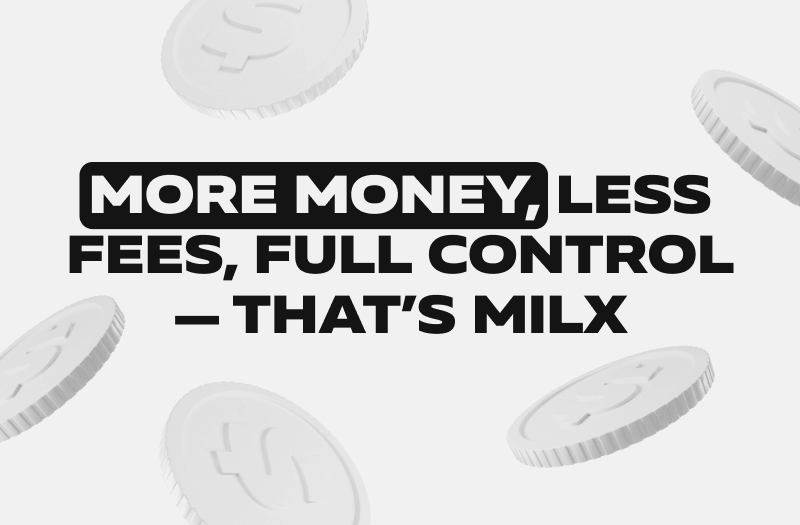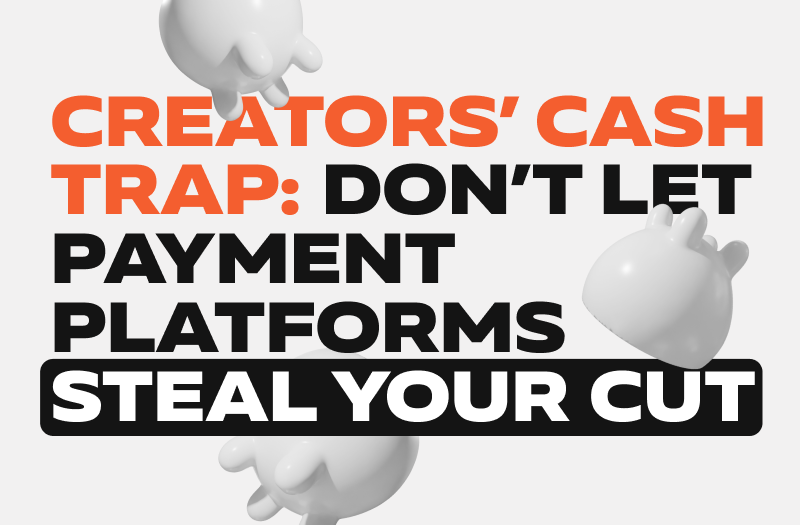At some point, YouTube stops being a side hustle — it becomes a business that makes money. And like any business, ignoring fees, bad habits, or tax rules can cost you a lot.
We've seen countless creators end the year wondering, "Where did my money go?" Today, we're walking you through a real-world example that shows exactly how successful creators lose up to $10,000 a year without realizing it and how to avoid it. Let's break it down!
Why YouTube Creators Lose Money on Payment Platforms
Let’s imagine a fairly successful YouTuber from the US who runs a tech blog. His channel has 300,000 subscribers and around 2.5 to 4 million views per month. His content includes high-quality gadget reviews, comparisons, expert interviews, and engaging experiments.
Here’s an approximate breakdown of his income structure:
- AdSense with a CPM ranging from $3 to $10, this brings in around $7,500 to $40,000 per month. Still, YouTube earnings per view can vary depending on factors such as CPM rates, audience location, and ad formats used.
- 3 sponsored integrations per month, each paying between $2,000–$6,000, adding another $6,000–$18,000.
- YouTube Memberships contribute an additional 7% of his income, which amounts to roughly $1,000–$2,800.
That adds up to approximately $14,500 to $60,800 per month. But here comes the reality check: a chunk of that money simply... disappears. Let’s break it down and see where it’s actually going.
But before we dive in, please note that all tax-related examples below are provided for informational purposes only. Actual tax obligations depend on your place of residence, business structure (LLC/Inc/DBA), expense levels, and type of income. Consulting a tax professional would be a good choice if you earn on YouTube.

Leak #1: High-Frequency Small Bank Transfers
Our tech creator receives payments from Google AdSense. He sends his AdSense payouts to a US business account via standard wire transfers:
- Bank transfer fee: $40 per transaction;
- 12 monthly transfers = $480/year;
But that’s not all. He occasionally moves funds to his personal account for smaller purchases (software, home office gear, etc.):
- 2 extra small transfers/month = 24 x $40 = $960/year.
Using high-fee wire transfers for low- or medium-sized recurring payouts is a costly mistake. For bank transfers, consolidate your payouts into larger sums. A business bank accounts often offer lower fees for LLCs or Sole Proprietors, so you can go with this option too. Some charge a flat $10–$15 or even waive transfer fees up to a limit.
When it comes to low- or medium-sized payouts, methods like MilX's Instant Card, PayPal or direct crypto transfers would slash the cost.
Save Money on YouTube Transfers
Choose from 10+ payment methods to transfer funds with the lowest fees for creators. Explore all payment methods, download MilX.

Leak #2: Paying Your Team via PayPal
Like many successful YouTubers, our creator has a production team of video editors, a designer, maybe even a scriptwriter. He spends around $1,500 per month on their work.
There are several YouTube payment methods available to pay your team, including bank transfers, PayPal, and wire transfers. PayPal is the go-to for paying freelancers, and that’s where the hidden fees sneak in.
Typical production team losses:
- Video editor from Ukraine: $1,000/month;
- Designer from the Philippines: $500/month.
What PayPal takes:
- Payments are made via PayPal from a USD account;
- Transaction fee: 4.4% + $0.30 next $1,500 × 4.4% = $66 + $0.30 = $66.30;
- Currency conversion fee: ~3–4%, If the freelancer gets paid in their local currency (like UAH or PHP), PayPal auto-converts at a poor rate, costing our YouTuber up to $45–$50 extra.
That’s a total loss of $110–$120 per month. Over a year, that adds up to more than $1,300 basically, the cost of a brand-new MacBook Pro lost entirely to fees.

Freelance Fees Are Eating Your Gear Budget
How MilX Helps to Save on Fees
MilX helps creators cut fees with 10+ payment methods and 40+ supported currencies, no extra conversions, bank charges, or delays.
You’re in control, move money your way: in the right currency, with zero-fee P2P, via crypto, or instantly for just 1%. It's fast, flexible, and saves you cash.
Our YouTuber could’ve easily sent salaries to his team in Ukraine and Philippines directly, with no transfer or conversion fees, using MilX P2P.
All he needs to do is invite his video editors to MilX. After that, payments between accounts are made without currency losses and absolutely no fees. No banks. No PayPal. No headache.
Leak #3: Currency Conversion Traps that Reduce Your Earnings
Imagine that our YouTuber works with sponsors. Sponsorships bring in $18,000/year. But not all brands pay in USD. About 30% of those deals are paid in EUR or GBP. His platform automatically converts to USD at:
- A hidden 2.5% exchange spread;
- That’s: $5,400 x 2.5% = $135/year quietly lost.
How Could this Look with MilX?
Mistake is letting the payout platform decide the conversion method. Once again, with MilX a creator could receive directly in EUR or GBP and convert only when rates are favorable.
So, he could easily:
- Withdraw earnings from AdSense and sponsors in the currency that suits him.
- Keep his balance in multiple currencies.
Don’t Let Platforms Pick Your Rate
With MilX, you control the conversion. Get paid in EUR or GBP, hold multiple currencies, and convert only when the rate’s right.
Leak #4: Loss Due to Late Submission of Tax Forms to Google
YouTube income tax refers to the taxes creators must pay on earnings generated from ads, sponsorships, and other sources, depending on their tax residency.
YouTube AdSense earnings are generated from ad impressions, clicks, and views, with a share of the ad revenue going to the creator.
Google AdSense asks creators to file a W-9 or W-8BEN yearly, based on their tax status.
- Miss the deadline, and Google will withhold 24% from your US earnings.
- Submit the form right, and you could pay less, or nothing at all, especially if you're a US resident with an LLC or S-Corp.
So if 50% of his views are from the U.S. and he skips the tax form, our YouTuber would lose $2,400 a month—or $28,800 a year—getting just $7,600 instead of $10,000. All from one missed form.
You can learn more about the tax system for YouTube creators in our blog YouTube Is Not Handling Your Taxes — You Should Do It Yourself.

Key Takeaways: Don’t Lose Your Hard-Earned Money
To save your YouTube earnings, optimize payment methods, avoid hidden fees, and use platforms like MilX for better rates and zero-fee transfers. Submit your tax forms on time to avoid unnecessary withholding taxes. By staying smart, you can keep more of your income and safeguard your hard work!

